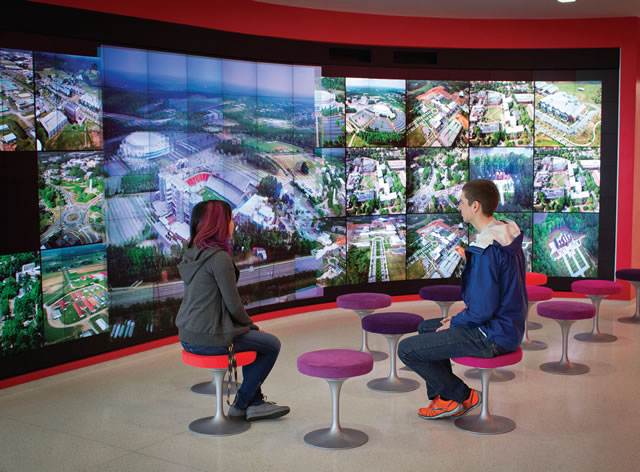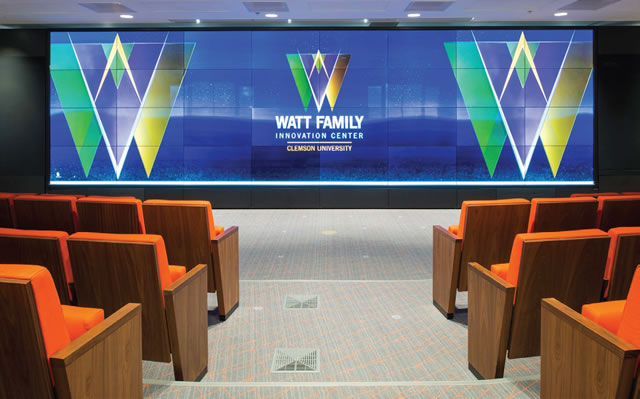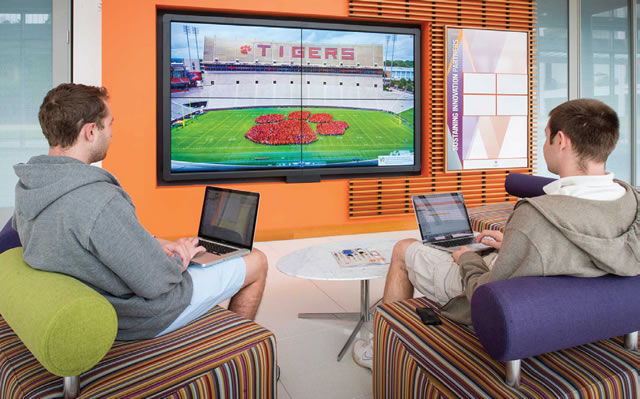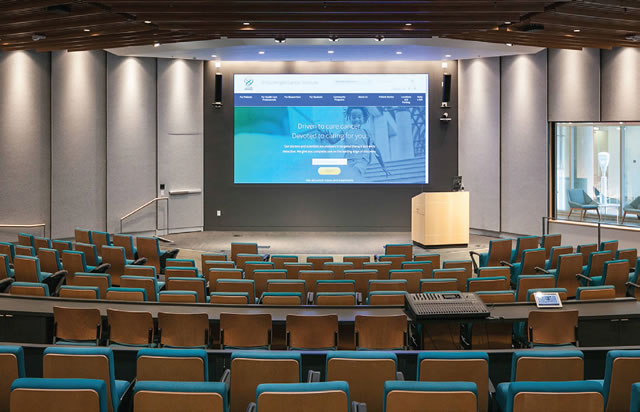3 Ways AV Can Draw People to Campus
Schools have come a long way from the days
of AV technicians pushing around carts with overhead projectors
or VHS players and tube TVs. Today, the audiovisual technology
supporting modern pedagogy is integrated into learning
spaces. And students and faculty are more likely than ever to
experience towering video walls in student centers, high-brightness
projectors lighting up lecture halls, and advanced visualization
systems that enable immersive, interactive learning.

Photo Courtesy of North Carolina State University
Video wall at North Carolina State University’s Hunt Library
In fact, such technology has become an expectation.
“Students come with an expectation that technology will be
available to them,” said Craig Park, principal at technology
consulting rm The Sextant Group, which has worked with
universities to create new audiovisual experiences. Park, who
has served the Society of College and University Planning
(SCUP) in various capacities, recently joined a panel at the
association’s EDspaces 2019 conference titled “Integrating the
Digital with the Physical to Create the Campus of the Future”
and moderated by AVIXA, the Audiovisual and Integrated
Experience Association.
As the panel explained, prospective students live in a
tech-rich, digital world, surrounded by audiovisual experiences.
Whether it’s on their smartphones, home entertainment
systems, or in public spaces like shopping centers and
entertainment districts, the digital lives of tomorrow’s learners
lead to preconceived notions of today’s campus. Colleges and
universities, therefore, are adopting AV technologies to meet
expectations and attract this generation of digital natives.
For an example encompassing a range of technologies, Park
pointed to North Carolina State University. “North Carolina
State’s Hunt Library [with AV designed by The Sextant
Group] is a good example of a university building that shows
off different kinds of technology-enabled learning spaces
that any department can draw from and use,” he noted. The
acclaimed Hunt Library, opened in 2012 and continuously refined, includes collaboration and visualization studios, media
labs, a gaming video wall and more.
Following are three ways savvy institutions are using AV
technology to catch students’ attention and create the visually
immersive campus of the future.
1) Making a First and Lasting Impression
AV solutions don’t only facilitate the education process. They
also serve to showcase a school’s ongoing commitment to
innovation, something prospective students anticipate when
visiting campuses. Many of these technologies work in the
background, unseen by students and instructors. Others sit
front and center, forming an integral part of a class lesson or
campus experience.
Breakthroughs in display technology are among the most
impactful ways that colleges are demonstrating their savviness.
Now broadly available, super-sized, single-panel LCD displays
with high brightness and resolution as well as fine-pitch LED
tiles and video walls that can produce large, bright images
have become essential building blocks for learning spaces and
campus-wide applications. Both technologies can be coupled
with wired and wireless content-sharing software, and both are
available with durable touchscreen overlays for full interactivity.
Recently, the University of Richmond finished its
56,000-square-foot, $26.5 million Queally Center, a welcome
center designed to serve as a “front door” for prospective
students, families and recruiters. AV experiences were central
to the Queally Center’s mission and design, said Doug West, assistant
vice president for Telecommunications, Media Support, User Services, and Academic Computing Services at the school.

Photo Courtesy of Clemson University
Clemson University’s Watt Center auditorium features an
interactive video wall measuring nearly 290 square feet.
“Visitors encounter video even before they enter the center,
with digital signage out in front,” West explained. “AV directs
them throughout the building, from the video walls and
touchscreen kiosks in the front, through a hallway lined with
screens, to a video wall at the end. It all leads to a conference
center with 12-foot screens, short-throw projectors and supporting
82-inch displays programmed with custom content.
It’s intended to be an immersive experience — and it is.”
School officials say the technology has improved the flow of people and processes, from recruiting freshmen to connecting
them with prospective employers. Bringing together
admissions, financial aid and career-counseling at the Queally
Center and sharing AV technology assets allows the school to
present a more united, cutting-edge front to students at all
stages of their education.
2) Communicating Innovation
Often, when colleges design and develop signature facilities,
such as North Carolina State’s Hunt Library,
audiovisual technology is practically
a required building material, included
to help communicate the building’s and
university’s mission. Clemson University’s
Watt Family Innovation Center, which
opened in 2016, exemplifies the school’s
commitment to delivering a 21st-century
education. The four-story, state-of-the-art
facility garnered well-deserved attention
for its devotion to interactive learning
(winning a Campus Technology Innovators
Award in 2016), but the unsung hero has
been the AV experiences it supports.
The Watt Center was designed around
and operates on a complement of nearly
200 displays, including an enormous multitouch LCD video wall, a 3D LCD video wall and 4K and
full HD LCD displays. Many of these displays are interactive,
equipped with multitouch technology, and offer wired and
wireless access to computers, laptops, tablets and other sources.
They can function as split-screen classroom whiteboards and
allow wireless sharing of information, ideas and projects, as well
as support digital signage, way finding, distance learning and
videoconferencing.

Photo Courtesy of Clemson University
The Watt Center’s interactive displays offer wired and
wireless access to computers, laptops, tablets and other sources.
Displays are designed into nearly every level of the building,
and in a wide variety of locations. For example, the first-floor lobby and atrium, which sees some 50,000 visitors per year,
is equipped with five video walls of different sizes and they all
showcase the display’s interactive capability in a very high-traffic environment. The second floor includes a large classroom
and ad hoc spaces for student collaboration, while the Academic
Resource Center features large 98-inch interactive displays
showing how to use advanced instructional technology.
The third floor is the main academic area, with classrooms,
workspaces and breakout rooms for student and staff collaboration.
Classroom technology includes 2D and 3D
video walls for advanced data visualization
and geographic information system (GIS)
instruction and a variety of LCD displays —
both installed and on movable carts — that
are wireless and touch enabled. The Watt
Center’s auditorium, a 187-seat space,
features an interactive video wall measuring
nearly 290 square feet, used for large presentations
and custom applications.
At Oregon Health and Science
University’s (OHSU) Knight Cancer
Institute, building designers had intended
for the institute’s new 320,000-square-foot
building to exploit an array of
ground-floor windows to tell its story. But
excessive light coming from outdoors rendered traditional signage unreadable. After evaluating display
technologies at a local expo, a decision was made to install an
LED video wall that wraps around an exterior-facing corner wall.

Photo Courtesy of Oregon Health and Science University
An LED video wall wraps around an exterior-facing corner wall
of Oregon Health and Science University’s Knight Cancer Institute.
“The video wall allows the institute to tell the story of the
science occurring in the building and change our message as
the science changes,” said Allen Tomlinson, director of Marketing
and Strategic Communications at the OHSU Knight
Cancer Institute.
And in a 200-seat auditorium located on the building’s
main floor, a four-screen-by-four screen LED video wall with
very fine pixel pitch was installed for scientific presentations
and to share data. Before upgrading to the new display technology,
presenters often experienced difficulty getting rooms
dark enough to show the very subtle variances that need to be
emphasized, such as the delicate contrast between different
cells. Now the images are sufficiently bright with accurate
enough color to present under normal room lighting.
The auditorium video wall also provides the Knight Cancer
Institute with a tool to engage the public. It will be used
throughout the year for the institute’s busy schedule of events,
including an international conference and a series of community-facing presentations called Knight School. “We’re also
planning on using the video wall as a backdrop for some TED
Talk-style presentations that will allow our scientists to inform
the community about the work they are doing,” Tomlinson said.
3) Appealing to Gamers, Too
Perhaps the most leading-edge use of audiovisual experiences
to lure tomorrow’s students is the rise of esports on college
campuses. In recent years, scores of U.S. colleges have established
varsity-level gaming teams and the National Association
of Collegiate Esports (NACE) was founded. Its first
convention was attended by 139 colleges and universities.
As much as esports is for participants, it’s also a spectator
activity, requiring a tech-enabled venue that makes watching gameplay engrossing. In 2019, Full Sail University, a
media-arts college in Winter Park, FL, opened The Fortress,
an 11,200-square-foot competitive gaming arena. The $6
million venue seats up to 500 spectators and is, by nature, an
AV-rich facility. In addition to the gaming stations on which
teams compete, fans follow the action on a 36-by-11.5-foot
LED video wall, the largest of several displays. There is also an
awe-inspiring circular LED display, 24 feet in circumference
and arrayed in a halo above the competition dais.
“What sets this apart from both other esports venues being
built on campuses and commercial esports arenas is that it’s
designed to accommodate spectators and act as an educational
facility,” said Bennett Newsome, Full Sail’s esports strategist.
“We can support events like invitational tournaments, but it’s
also a complete classroom environment.”
Indeed, the nature of today’s audiovisual technology is
such that it can play multiple roles on campus. Using AV,
college and university planners can create digital canvasses
that support different missions — perhaps the most important
of which is to connect with incoming students and the
community. In addition, weaving modern AV solutions into
the classroom experience exposes students to new modes of
collaboration that will serve them well in the workforce.
Ron Cramer, a technology consultant at the University of
Wisconsin, explained at EDspaces 2019 that feedback from alumni
and local corporations about the skills students need coming
out of school has influenced the application of technology. “We’re
using AV technology that can help students become more effective
at communicating and team building,” Cramer said. “This is
the kind of environment we want to produce for them.”

Photo Courtesy of Oregon Health and Science University
A video wall in the Knight Cancer Institute’s auditorium provides
the brightness and color accuracy needed for scientific presentations.
This article originally appeared in the January/February 2020 issue of Spaces4Learning.